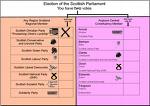
We must increase, not reduce voter choice.

We must increase, not reduce voter choice.
There seems to be a sort of consensus threatening to emerge over the idea that we may get, alongside PR-STV in the constituencies, some form of list system. This is to be welcomed, provided that it meets certain criteria:
1. That it be a National list. A regional list system, based on, say, euro constituncies, will defeat the purpose, in that we’ll just have deputies running around their super constituencies. Even with a national list, we’ll still have deputies trying to build a local base somewhere in the country. That’s the nature of the Irish political beast. The difference is that if it is a national list then voters can pick individual candidates based on something other than “he’s from my parish.”
2. That it be an Open list. It’s no use just letting parties publish their candidates and say “Just tick yay or nay to the whole package.” That defeats the purpose, which is to improve voter choice. By all means, allow voters to tick a box if they wish to vote for a particular party list, but they must also have a choice to vote for individual candidates. Voters should have more than one vote (I would say 5 votes of equal value) to allow them to take advantage of the wide choice of candidates available. What’ll be interesting is that unlike in the UK, where leftwingers anywhere could vote for say, Tony Benn, under such a system, many existing Irish deputies, who have little going for them other than the area they are from, will struggle under such a system. They won’t have a broad issue base to appeal wider, whereas more policy orientated candidates will have a wider appeal. Colm O’Gorman on child protection issues, or Michael O’Leary appealing to businessmen acrosss the country, for example. This is how (hopefully) we’ll bring new people into the system.
3. There must be at least 30 seats. This is to keep the quota low, and allow small parties and independent candidates get elected. it will also allow non-Dublin candidates get elected.
4. Quotas for men and women. Each party should by law be required to ensure 40% of their list be made up of each sex, and that they be listed alternately male/female. If FF and FG are saying that they cannot find 15 competant women in their respective parties, they’re telling us a lot about their parties.
This can work, and can transform to a certain degree, although, as Trinity’s Elaine Byrne has pointed out, the culture has to change too. My own feeling is that both the political culture and the electoral system effect each other, and that this is a worthy first step.

Just a quick FYI but a list system component will not apparently be part of the Fine Gael New Politics to be launched tomorrow. So Big Phil Hogan said on Saturday
Joseph, You are right, the Dail does indeed represent geographical interests, and that to me is the problem, in that so many of the issues faced by our nation are far more complex than what is good for my parish? I don’t actually think that too much party affiliation is the problem. If anything, there is too little. We are very limited in our political choices in this country, espc when one considers our two largests parties basically stand for the creed of “As little change as we can get away with”. An open list system could allow the emergence of small parties from small businessman’s parties to conservative catholic parties to liberal parties to marxist parties that would have broader support across the country rather than targetted in a single constituency.
STV is a good system, but to make it work properly we’d need huge 20 seat constituencies (to allow for an effective 5% quota) and counting that would be challenging at best.
The big issue as I see it with this proposal is that what you’re seeking – more people elected based on individual policies or group interests – could be better applied to reforming the upper house. TDs are supposed to represent their geographical constituents – wouldn’t it undermine that slightly to introduce a whole plethora of different ‘reasons to be’ for them, particularly when it would be much better done by setting up the upper house as a vehicle for what you describe instead?
There’s also the slight issue that if done wrongly a list system does threaten to just become an unwelcome vehicle for party interests even in an open list system. Ideally, people will vote because they agree with the candidate, but there’s a far greater chance they’ll just vote based on party. I’m not sure how you’d deal with that, though. A STV system in bigger seats (of course, this couldn’t happen for the lower house) with party affiliation taken out of the picture (ranging on the mild end from ‘don’t mention it on ballot papers’, to more radically ‘don’t let parties campaign for an upper house candidate’, or even ‘don’t let upper house candidates be a member of a registered political party’) would seem best to me, although you do run the risk of confusing the electorate with parallel STV systems as such.
Pingback: Electoral Reform and the List System | Stephen Spillane